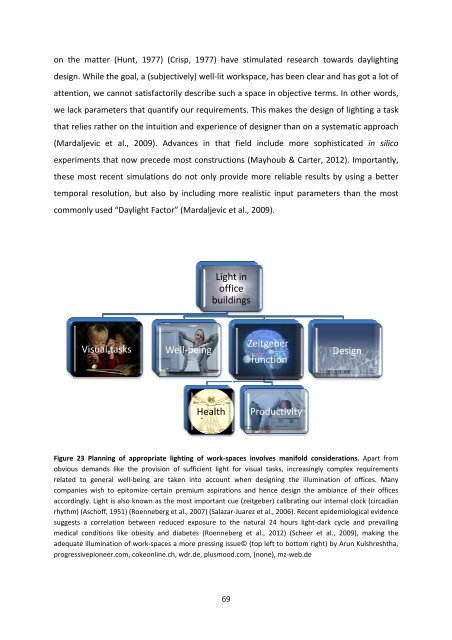MASTER THESIS Biomimetic potential of sponge ... - IAP/TU Wien
MASTER THESIS Biomimetic potential of sponge ... - IAP/TU Wien
MASTER THESIS Biomimetic potential of sponge ... - IAP/TU Wien
You also want an ePaper? Increase the reach of your titles
YUMPU automatically turns print PDFs into web optimized ePapers that Google loves.
on the matter (Hunt, 1977) (Crisp, 1977) have stimulated research towards daylighting<br />
design. While the goal, a (subjectively) well-lit workspace, has been clear and has got a lot <strong>of</strong><br />
attention, we cannot satisfactorily describe such a space in objective terms. In other words,<br />
we lack parameters that quantify our requirements. This makes the design <strong>of</strong> lighting a task<br />
that relies rather on the intuition tion and experience <strong>of</strong> designer than on a systematic approach<br />
(Mardaljevic et al., 2009). Advances in that field include more sophisticated in silico<br />
experiments that now precede most constructions (Mayhoub & Carter, 2012). Importantly,<br />
these most recent simulations do not only provide more reliable results by using a better<br />
temporal resolution, but also by including more realistic input parameters than the most<br />
commonly used “Daylight Factor” (Mardaljevic et al., 2009).<br />
Light in<br />
<strong>of</strong>fice<br />
buildings<br />
Visual tasks<br />
Well-being<br />
Zeitgeber<br />
function<br />
Design<br />
Health<br />
Productivity<br />
Figure 23 Planning <strong>of</strong> appropriate lighting <strong>of</strong> work-spaces involves manifold considerations. Apart from<br />
obvious demands like the provision <strong>of</strong> sufficient light for visual tasks, increasingly complex requirements<br />
related to general well-being are taken into account when designing the illumination <strong>of</strong> <strong>of</strong>fices. Many<br />
companies wish to epitomize certain premium aspirations and hence design the ambiance <strong>of</strong> their <strong>of</strong>fices<br />
accordingly. Light is also known as the most important cue (zeitgeber) calibrating our internal clock (circadian<br />
rhythm) (Asch<strong>of</strong>f, 1951) (Roenneberg et al., 2007) (Salazar-Juarez et al., 2006). Recent epidemiological evidence<br />
suggests a correlation between reduced exposure to the natural 24 hours light-dark cycle and prevailing<br />
medical conditions like obesity and diabetes (Roenneberg et al., 2012) (Scheer et al., 2009), making the<br />
adequate illumination <strong>of</strong> work-spaces a more pressing issue© (top left to bottom right) by Arun Kulshreshtha,<br />
progressivepioneer.com, cokeonline.ch, wdr.de, plusmood.com, (none), mz-web.de<br />
69

















